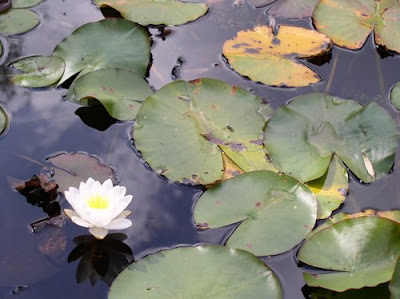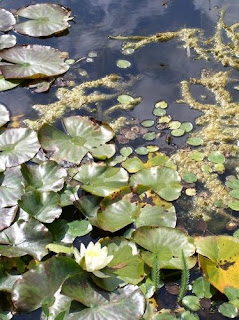
There was one of the water lilies paintings in the “Impressionism from France and America” exhibition I visited in August in Montpellier (France).
While I admired the audacity of the treatment, I could not resist the thought that painting water lilies had become almost impossible after Monet. This subject is so associated with Monet that either you paint water lilies as homage to the great impressionist artist or you pass for a pale imitator. Whatever you do, you cannot escape the comparison.
The only option would be to reinvent the subject by taking a radical new approach to it and find a new artistic treatment.
What can we learn from Monet’s choice?
- When Monet started the series in 1885, water lilies were not an obvious subject for a painting. I am not aware of any other painter who has used them as his main painting subject. In a way, Monet “invented” the subject.
- This subject has a lot to offer: the curves of the plants, the reflexions in the water, the white flowers acting like a screen to catch reflected lights and shadows, the transparence of the water. The large panels represent the water without edges or boundaries, punctuated with the water lily pads and flowers and clouded by the inverted image of the surrounding trees. Monet turned an ordinary subject into extraordinary paintings celebrating calm and harmony.
- Monet was a keen gardener and his passion for plants and flowers shows in his paintings. You have to embrace your painting subjects. You should not paint anything that does not appeal to you.
- This subject was on Monet’s doorstep. I concede that any painter would be happy to have free access to a garden like Giverny’s garden to paint in. The advantage for Monet was the proximity of the studio. In summer, he could paint in the garden and complete plein-air studies. In winter, he would retreat into his close-by studio and work on the large panels, using his studies and working from memory. We often overlook interesting subjects that lay few hundred metres from our houses or even in our back garden.
- The groundbreaking idea was to blow-up the subject and paint water lilies pads and flowers on large canvases. Monet did around 300 paintings of the water garden, including more than 40 large panels. Most of the large panels (like the murals of the Musée de l'Orangerie in Paris) show life size water lilies.
- Monet built-up a series of works inspired by his water garden between 1885 and 1926 (the year of his death). He used the subject like a musician practices scales and arpeggios, playing on the full extent of his palette. As time went by, works became more and more abstract. Colours and textures took precedence over the subject itself, now well known to the painter. In the last years, Monet suffered of a double cataract that led to a blurred vision and left him almost blind in the end. This probably accounts in part for the abstract nature of his latest work.

So, water lilies are a difficult territory because Monet mastered them, put his trademark on the subject and raised the bar for any follower. The good news is that there are plenty of subject that we can make ours.
Where can you see Monet’s water lilies paintings?
The Marmottan museum in Paris (France) offers a good selection of Monet’s paintings.
Monet’s sketchbooks , also at the Marmottan museum, contain some preparatory drawings for the water lilies paintings.
The Musée de l'Orangerie (in Paris) exhibits the water lilies murals in a special oval room. You can take a Virtual tour of the Water lilies murals here .
The following American museums also have water lilies paintings in their collections:
- The Museum of Modern Art in New York. Reflections of Clouds on the Water-Lily Pond. c. 1920. Oil on canvas, three panels, Each 6' 6 3/4" x 13' 11 1/4" (200 x 424.8 cm), overall 6' 6 3/4" x 41' 10 3/8" (200 x 1276 cm).
- The Metropolitan Museum of Art
- Art Institute of Chicago
- Portland Art Museum
monet water lilies painting subject giverny garden art l'orangerie museum art history monet sketchbooks museum modern art metropolitan museum of art art institute of chicago portland art museum

No comments:
Post a Comment